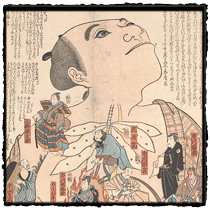 Introduction
by Laura W. Allen
The UCSF Japanese Woodblock Print Collection consists of four hundred
Japanese woodblock prints on health-related themes. Of those, more than half are
colorfully illustrated in the ukiyo-e manner, the remainder being printed single-sheet
texts.
From the treatment and prevention of diseases like smallpox, measles, and cholera, to the
stages of pregnancy and drug advertisements, these prints offer a unique window into
traditional Japanese attitudes toward health and illness.
The majority of the prints date to the mid- to late nineteenth century, when Japan
was opening to the West after almost two hundred and fifty years of self-imposed
isolation. Thus, they provide valuable pictorial evidence for the effect of Western
medical science on traditional beliefs and practices.
Five subject areas broadly define the collection. The treatment and prevention of
three contagious diseases — smallpox, measles, and cholera — are topics for eighty of the
prints. A related category includes prints in which Buddhist or Shinto deities intervene to
ensure a cure. Pregnancy and women's health issues form a distinct theme, including
several images of the stages of gestation. Because foreigners were thought to carry
disease to Japan, the collection also includes several maps of Nagasaki, where the Dutch
were confined during the Edo period, as well as prints depicting foreigners and their
ships. Drug advertisements from the nineteenth century make up the largest category.
Prints on other topics include works describing ordinary medical or psychological
conditions, such as dizziness or nightmares, prints relating to nutrition, and those
portraying the internal operations of the human body.
The woodblock prints in this collection offer a fascinating visual account of
Japanese medical knowledge in the late Edo and Meiji periods. Collectively, they record
a gradual shift, by the late nineteenth century, from the reliance on gods and charms for
succor from disease, to the adoption of Western, scientific principles as the basis for
medical knowledge. They show the introduction of imported drugs and vaccines and
increased use of printed advertisements to promote new medicinal products.
The ukiyo-e tradition
When considering these specialized prints, it is worth asking how they relate to the
larger tradition of Japanese woodblock printmaking. Today, Japanese prints are most
often referred to as ukiyo-e, or "pictures of the floating world." In the late seventeenth
century, the ukiyo-e print emerged from the world of the pleasure quarters or licensed
entertainment districts, located in most major urban centers.
A constant theme of Edo period (1615-1868) ukiyo-e is the celebrity inhabitant of
this world: the famous Kabuki actors and sophisticated female entertainers (geisha) who
served in the pleasure quarter's brothels and restaurants. Although actor and beauty
themes remained popular, by the 1830s and 1840s, two new genres had risen to
prominence: landscapes, like the famous views of Mt. Fuji by Hokusai (1760-1849), and
figures from history and legend, including warriors, ghosts, deities, demons, and a wide
array of comic and anthropomorphic imagery.
After 1854, when Commodore Matthew Perry forced Japan to open its ports to
American and European traders, print designers turned to the theme of foreigners and
their customs, and increasingly, Japan's modernization during the ensuing Meiji era
(1868-1912).
|
|
View by Theme
|

